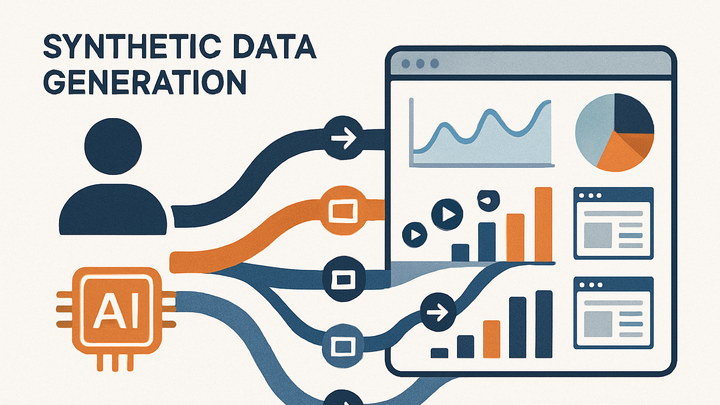Published on 2025-06-22T06:21:12Z
What is Synthetic Data? Examples in Analytics
Synthetic data is artificially generated information that replicates the statistical properties of real user analytics data without exposing actual personal information. It provides a safe way to test analytics pipelines, train machine learning models, and share privacy-preserving reports. It can be generated via statistical models, rule-based approaches, or advanced machine learning techniques such as Generative Adversarial Networks (GANs) and Variational Autoencoders (VAEs). Synthetic data helps organizations overcome data scarcity, uphold compliance with privacy regulations like GDPR, and accelerate feature testing.
Example PlainSignal integration:
<link rel='preconnect' href='//eu.plainsignal.com/' crossorigin />
<script defer data-do='yourwebsitedomain.com' data-id='0GQV1xmtzQQ' data-api='//eu.plainsignal.com' src='//cdn.plainsignal.com/plainsignal-min.js'></script>
Synthetic data
Artificially generated data that mimics real analytics events to improve testing, model training, and privacy compliance.
Definition and Importance
This section defines synthetic data and explains its significance in the field of analytics, highlighting key advantages and motivations for its adoption.
-
Synthetic data defined
Synthetic data refers to artificially generated information that maintains the statistical properties of real-world data without exposing actual user details.
-
Key benefits
Synthetic data offers various advantages for analytics teams, including enhanced privacy, scalability, and bias mitigation.
-
Privacy protection
Eliminates exposure of real personal identifiers, ensuring compliance with privacy regulations.
-
Scalability
Enables the creation of large datasets on demand, accelerating development and testing.
-
Bias mitigation
Helps balance underrepresented segments by augmenting existing datasets.
-
Generation Techniques
Overview of common methods for creating synthetic data, ranging from statistical approaches to advanced machine learning models.
-
Random sampling
Generates data by sampling values from predefined distributions to approximate real data patterns.
-
Uniform sampling
Produces values evenly distributed across a specified range.
-
Gaussian sampling
Mimics normal distribution curves common in user behavior metrics.
-
-
Statistical modeling
Fits statistical models (e.g., regression, mixture models) to real data and samples new points from the fitted models.
-
Machine learning approaches
Leverages neural networks to learn data distributions and generate high-fidelity synthetic samples.
-
Generative adversarial networks (gans)
Two networks contest each other to produce increasingly realistic synthetic data.
-
Variational autoencoders (vaes)
Encodes data into a latent space and decodes it back to generate new data points.
-
Use Cases in Analytics
Explores practical applications of synthetic data within analytics workflows and machine learning projects.
-
Testing and qa
Use synthetic events to validate analytics pipelines, dashboards, and reporting features before they go live.
-
Load testing
Simulate high traffic volumes to ensure infrastructure and analytics systems handle peak loads.
-
Feature testing
Validate new UI components and data flows in isolation from real user data.
-
-
Model training and validation
Augment real datasets with synthetic samples to improve machine learning model accuracy and robustness.
-
Privacy-preserving reporting
Generate aggregated insights for stakeholders without risking exposure of sensitive user information.
Implementation with SAAS Tools
Guidance on integrating synthetic data workflows into popular analytics platforms like GA4 and PlainSignal.
-
Google analytics 4 (GA4)
Although GA4 doesn’t natively generate synthetic data, you can import synthetic events via the Measurement Protocol to test and debug pipelines.
-
Measurement protocol
Send HTTP requests with synthetic payloads to the GA4 endpoint to simulate user interactions.
-
-
PlainSignal
Inject synthetic events into PlainSignal for QA and demos with this snippet:
<link rel='preconnect' href='//eu.plainsignal.com/' crossorigin /> <script defer data-do='yourwebsitedomain.com' data-id='0GQV1xmtzQQ' data-api='//eu.plainsignal.com' src='//cdn.plainsignal.com/plainsignal-min.js'></script>
Challenges and Considerations
Discusses potential pitfalls, ethical considerations, and technical challenges when working with synthetic data.
-
Data quality and realism
Ensuring that synthetic data accurately reflects the complexity and edge cases of real-world data can be difficult.
-
Ethical and legal compliance
Understand and adhere to regulations around data generation and usage, especially when simulating sensitive attributes.
-
Overfitting and artifacts
Synthetic algorithms may introduce patterns not present in real data, leading to misleading insights if not validated.
-
Resource costs
Complex generation methods like GANs can be computationally expensive and time-consuming.
